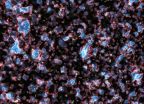(Press-News.org) A European team of astronomers using ESO's Very Large Telescope (VLT) has measured the distance to the most remote galaxy so far. By carefully analysing the very faint glow of the galaxy they have found that they are seeing it when the Universe was only about 600 million years old (a redshift of 8.6). These are the first confirmed observations of a galaxy whose light is clearing the opaque hydrogen fog that filled the cosmos at this early time. The results will be presented at an online press conference with the scientists on 19 October 2010, and will appear in the 21 October issue of the journal Nature.
"Using the ESO Very Large Telescope we have confirmed that a galaxy spotted earlier using Hubble is the most remote object identified so far in the Universe" [1], says Matt Lehnert (Observatoire de Paris) who is lead author of the paper reporting the results. "The power of the VLT and its SINFONI spectrograph allows us to actually measure the distance to this very faint galaxy and we find that we are seeing it when the Universe was less than 600 million years old."
Studying these first galaxies is extremely difficult. By the time that their initially brilliant light gets to Earth they appear very faint and small. Furthermore, this dim light falls mostly in the infrared part of the spectrum because its wavelength has been stretched by the expansion of the Universe — an effect known as redshift. To make matters worse, at this early time, less than a billion years after the Big Bang, the Universe was not fully transparent and much of it was filled with a hydrogen fog that absorbed the fierce ultraviolet light from young galaxies. The period when the fog was still being cleared by this ultraviolet light is known as the era of reionisation [2]. Despite these challenges the new Wide Field Camera 3 on the NASA/ESA Hubble Space Telescope discovered several robust candidate objects in 2009 [3] that were thought to be galaxies shining in the era of reionisation. Confirming the distances to such faint and remote objects is an enormous challenge and can only reliably be done using spectroscopy from very large ground-based telescopes [4], by measuring the redshift of the galaxy's light.
Matt Lehnert takes up the story: "After the announcement of the candidate galaxies from Hubble we did a quick calculation and were excited to find that the immense light collecting power of the VLT, when combined with the sensitivity of the infrared spectroscopic instrument, SINFONI, and a very long exposure time might just allow us to detect the extremely faint glow from one of these remote galaxies and to measure its distance."
On special request to ESO's Director General they obtained telescope time on the VLT and observed a candidate galaxy called UDFy-38135539 [5] for 16 hours. After two months of very careful analysis and testing of their results, the team found that they had clearly detected the very faint glow from hydrogen at a redshift of 8.6, which makes this galaxy the most distant object ever confirmed by spectroscopy. A redshift of 8.6 corresponds to a galaxy seen just 600 million years after the Big Bang.
Co-author Nicole Nesvadba (Institut d'Astrophysique Spatiale) sums up this work, "Measuring the redshift of the most distant galaxy so far is very exciting in itself, but the astrophysical implications of this detection are even more important. This is the first time we know for sure that we are looking at one of the galaxies that cleared out the fog which had filled the very early Universe."
One of the surprising things about this discovery is that the glow from UDFy-38135539 seems not to be strong enough on its own to clear out the hydrogen fog. "There must be other galaxies, probably fainter and less massive nearby companions of UDFy-38135539, which also helped make the space around the galaxy transparent. Without this additional help the light from the galaxy, no matter how brilliant, would have been trapped in the surrounding hydrogen fog and we would not have been able to detect it", explains co-author Mark Swinbank (Durham University).
Co-author Jean-Gabriel Cuby (Laboratoire d'Astrophysique de Marseille) remarks: "Studying the era of reionisation and galaxy formation is pushing the capability of current telescopes and instruments to the limit, but this is just the type of science that will be routine when ESO's European Extremely Large Telescope — which will be the biggest optical and near infrared telescope in the world — becomes operational."
INFORMATION:
Notes
[1] An earlier ESO result (eso0405) reported an object at a larger distance (a redshift of 10). However, further work failed to find an object of similar brightness at this position, and more recent observations with the NASA/Hubble Space Telescope have been inconclusive. The identification of this object with a galaxy at very high redshift is no longer considered to be valid by most astronomers.
[2] When the Universe cooled down after the Big Bang, about 13.7 billion years ago, electrons and protons combined to form hydrogen gas. This cool dark gas was the main constituent of the Universe during the so-called Dark Ages, when there were no luminous objects. This phase eventually ended when the first stars formed and their intense ultraviolet radiation slowly made the hydrogen fog transparent again by splitting the hydrogen atoms back into electrons and protons, a process known as reionisation. This epoch in the Universe's early history lasted from about 150 million to 800 million years after the Big Bang. Understanding how reionisation happened and how the first galaxies formed and evolved is one of the major challenges of modern cosmology.
[3] These Hubble observations are described at: http://www.spacetelescope.org/news/heic1001/
[4] Astronomers have two main ways of finding and measuring the distances to the earliest galaxies. They can take very deep images through differently coloured filters and measure the brightness of many objects at different wavelengths. They can then compare these with what is expected of galaxies of different types at different times in the Universe's history. This is the only way currently available to discover these very faint galaxies and is the technique employed by the Hubble team. But this technique is not always reliable. For example, what may seem to be a faint, very distant galaxy can sometimes turn out to be a mundane, cool star in our Milky Way.
Once candidate objects are found more reliable estimates of the distance (measured as the redshift) can be obtained by splitting the light from a candidate object up into its component colours and looking for the telltale signs of emission from hydrogen or other elements in the galaxy. This spectroscopic approach is the only means by which astronomers can obtain the most reliable and accurate measurements of distance.
[5] The strange name indicates that it was found in the Ultra Deep Field search area and the number gives its precise position on the sky.
Clearing the cosmic fog
The most distant galaxy ever measured
2010-10-21
ELSE PRESS RELEASES FROM THIS DATE:
UT MD Anderson scientists show TAp63 suppresses cancer metastasis
2010-10-21
HOUSTON - Long overshadowed by p53, its famous tumor-suppressing sibling, the p63 gene does the tougher, important job of stifling the spread of cancer to other organs, researchers at The University of Texas MD Anderson Cancer Center report in the Oct. 21 issue of Nature.
Not only does a specific form of p63 protein block metastasis, but it does so by activating the enzyme Dicer, which plays a pivotal role in the creation of micro RNAs, tiny bits of RNA that regulate a host of cellular processes.
"p63 is a master regulator of metastasis, an important role in its own ...
Mount Sinai researchers find potential therapeutic target across a range of cancer types
2010-10-21
Researchers from Mount Sinai School of Medicine, in collaboration with investigators of the National Institute of Health and Medical Research (INSERM) of France led by Nicolae Ghinea, PhD, have found a common link among several malignant tumor types in all grades of cancer. This breakthrough may ultimately provide a new diagnostic or therapeutic target to detect cancer early or stop tumor growth. The study is published in the October 21 issue of The New England Journal of Medicine.
The team discovered that a hormone receptor typically found in human reproductive organs ...
New tumor proteins may identify a range of cancers early
2010-10-21
COLUMBUS, Ohio – A new study led by Ohio State University cancer researchers describes a novel cancer-specific protein that is present in a broad range of cancer types and at all stages of tumor development, from premalignant cells to metastatic tumor cells.
If verified, the antigen could serve as a marker for the early detection and treatment of primary and metastatic tumors, and provide a target for the development of anticancer therapies, the researchers say.
In addition, a vaccine designed to target these cancer-cell proteins, called Piwil2-like (PL2L) proteins, ...
New industrial application for revolutionary forensic metal fingerprinting technique
2010-10-21
Groundbreaking research into fingerprint detection developed at the University of Leicester now has an industrial application, thanks to a new invention by the scientist who developed the technique.
Dr John Bond's method of identifying fingerprints on brass bullet-casings, even after they have been wiped clean, was based on the minuscule amounts of corrosion which can be caused by sweat. First announced in 2008, this breakthrough was cited as one of the technologies 'most likely to change the world' by a panel of experts for BBC Focus magazine and was included in Time ...
NTU researchers develop world's smallest on-chip low-pass filter
2010-10-21
A research team from Nanyang Technological University (NTU) has successfully designed the world's smallest on-chip low-pass filter which is 1,000 times smaller than existing off-chip filters.
A low-pass filter is a circuit that allows low-frequency signals to pass through while reducing unwanted high-frequency signals from passing through. Compared to existing off-chip filters, which are discrete and bulky components, on-chip filters occupy a small area on integrated circuit chips, which can be found in portable devices such as mobile phones, laptops, vehicle-mounted ...
Measuring sea-level rise in the Falklands
2010-10-21
Sea levels around the Falkland Islands in the South Atlantic have risen since the mid nineteenth century and the rate of sea-level rise has accelerated over recent decades, according to newly published research. The findings are as expected under global warming and consistent with observations elsewhere around the globe.
"We have been fortunate in being able to compare modern sea-level measurements obtained from tide gauges and from satellite radar altimeters with historical measurements made at Port Louis in the Falkland Islands in 1842," explained researcher Prof. Philip ...
Eating mostly whole grains, few refined grains linked to lower body fat
2010-10-21
BOSTON (October 20, 2010) - People who consume several servings of whole grains per day while limiting daily intake of refined grains appear to have less of a type of fat tissue thought to play a key role in triggering cardiovascular disease and type 2 diabetes, a new study suggests. Researchers at the Jean Mayer USDA Human Nutrition Researcher Center on Aging (USDA HNRCA) at Tufts University observed lower volumes of visceral adipose tissue (VAT) in people who chose to eat mostly whole grains instead of refined grains.
"VAT volume was approximately 10 % lower in adults ...
Cancer: Discovery of a very promising biological marker
2010-10-21
The follicle stimulating hormone, FSH, targets the human reproductive organs: the ovaries and testicles. In women, it stimulates maturation of ovarian follicles and production of oestrogens (via its action on granulosa cells). In men, it stimulates production of spermatozoa (via its action on the Sertoli cells).
FSH receptor, which was the subject of the work carried out by the Inserm researchers, is normally only found in cells stimulated by FSH (granulosa cells in women and Sertoli cells in men). However, it is also present in very small quantities in the blood vessels ...
Small is beautiful in hydroelectric power plant design, and good for the environment
2010-10-21
Hydroelectric power is the oldest and the "greenest" source of renewable energy. In Germany, the potential would appear to be completely exploited, while large-scale projects in developing countries are eliciting strong criticism due to their major impact on the environment. Researchers at Technische Universitaet Muenchen (TUM) have developed a small-scale hydroelectric power plant that solves a number of problems at the same time: The construction is so simple, and thereby cost-efficient, that the power generation system is capable of operating profitably in connection ...
New equation could advance research in solar cell materials
2010-10-21
ANN ARBOR, Mich.---A groundbreaking new equation developed in part by researchers at the University of Michigan could do for organic semiconductors what the Shockley ideal diode equation did for inorganic semiconductors: help to enable their wider adoption.
Without the Shockley equation, the computers of today would not be possible.
Developed in 1949 by William Shockley, the inventor of the transistor, the Shockley equation describes the relationship between electric current and voltage in inorganic semiconductors such as silicon.
The new equation describes the ...
LAST 30 PRESS RELEASES:
New design playbook could unlock next generation high energy lithium ion batteries
Drones reveal how feral horse units keep boundaries
New AI tool removes bottleneck in animal movement analysis
Bubble netting knowledge spread by immigrant humpback whales
Discovery of bats remarkable navigation strategy revealed in new study
Urban tributaries identified as major sources of plastic chemical pollution in the Yangtze River
UK glaucoma cases higher than expected and projected to reach 1.6 million+ by 2060
Type 2 diabetes prevention could more than halve carbon footprint linked to disease complications
Over 1 million estimated to have glaucoma in UK
Early treatment can delay rheumatoid arthritis for years
National childhood type 1 diabetes screening is effective and could prevent thousands of emergency diagnoses, UK study shows
Mix of different types of physical activity may be best for longer life
Continuous care from community-based midwives reduces risk of preterm birth by 45%
Otago experts propose fiber as first new essential nutrient in 50 years
Auburn Physics PhD student earns prestigious DOE Fellowship
AI tool helps you learn how autistic communication works
To show LGBTQ+ support, look beyond Pride Month
Using artificial intelligence to understand how emotions are formed
Exposure to wildfire smoke late in pregnancy may raise autism risk in children
Breaking barriers in lymphatic imaging: Rice’s SynthX Center leads up to $18 million effort for ‘unprecedented resolution and safety’
Dhaval Jadav joins the SETI Institute Board to help spearhead novel science and technology approaches in the search for extraterrestrial life
Political writing retains an important and complex role in the national conversation, new book shows
Weill Cornell Medicine receives funding to develop diagnostic toolbox for lymphatic disease
It started with a cat: How 100 years of quantum weirdness powers today’s tech
McGill researchers identify a range of unexpected chemical contaminants in human milk
Physical therapy research highlights arthritis’ toll on the workforce — and the path forward
Biomedical and life science articles by female researchers spend longer under review
Forgetting in infants can be prevented in mice by blocking their brain’s immune cells
Blocking immune cells in the brain can prevent infant forgetting
AI-driven ultrafast spectrometer-on-a-chip: A revolution in real-time sensing
[Press-News.org] Clearing the cosmic fogThe most distant galaxy ever measured



